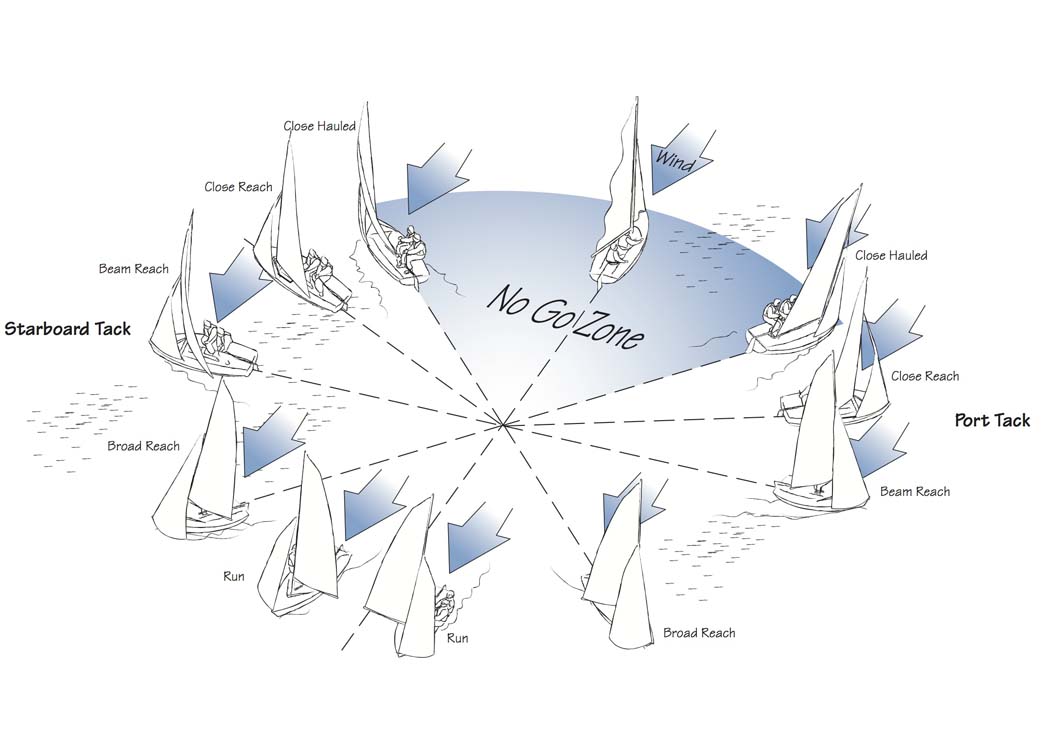.
We have made good progress in the class. We know how to rig up the
boats... although I did see a few knots being tied twice with a frown...
We can hoist the sails... We know how to steer with a tiller... We are
not quite sure about Points of Sail and Tacking, but we're getting the
boats going pretty well much of the time. Some of the cadets have
definitely found the Javelin's gas pedal!
Here we see Coach Hallquist's team, which includes an advanced sailor, rigging the mainsail on their Javelin. You can tell that the coach is not really needed at this point
.

Here is Coach Jackson's team already out sailing. Can you identify any mistakes they are making? For one obvious catch, YES the skipper should be looking where he is going! But there are a few other minor things that could be done better.
The real key to basic sailing is to always know the wind direction. Everything about what the boat is doing, or what to do with the boat, follows from wind direction.
Most of the sailing class is probably tired of hearing about POINTS OF SAIL. However, we must be able to figure this out before being able to do anything further.
Just to help refresh the memory, here are the Points of Sail.
What is the difference between Port Tack and Starboard Tack? This can be very important!
.

Which boat here has the Right-Of-Way? Both boats are on a Beam Reach (approximately).
Once we know the Points Of Sail, we can learn the maneuvers. Today we practiced Tacking, and many of the cadets could make decent tacks. All needed more practice, especially if we expect to be sailing the FJs! A sloppy tack can stall or capsize an FJ.

Success!
Coach said "Sail right to that buoy" and they did!
Notice the jib is backwinded (deliberately trimmed to the windward side). This helps steady the boat and slow it down. Usually a maneuver we teach advanced cadets, but it comes in handy when getting untangled.
.
OK, let's talk about TACKING.
A TACK is a turn. It can be a turn from port to starboard, or the other way. However, a tack ALWAYS swings the bow towards the wind, then past the wind, so that the sails change sides.

The first step of a tack is to get ready. The lookout must confirm that the path is clear, crew must be ready to handle the sails and to shift their weight (especially when it's windy).
The next step is the actual turn. The skipper will always put the tiller TOWARDs the sail, and hold it there for a brief time.
The crew should release the jib sheet, and start trimming ... slowly... on the new sheet. Why slowly? Because if you backwind the jib (see photo above) it will stop the boat's turn, and the tack will fail. We know this is true, because it happened several times today!
A successful tack is from CLOSE-HAULED to CLOSE-HAULED, Spinning the boat around from a beam reach to a beam reach might work, but is likely to fail because the sails flog for most of the turn.
What happens if the boat is on a BROAD REACH and the skipper pulls the tiller away from the sail? And keeps turning until the sails change sides? We saw that happen several times today too.

Here is a crew under good control and sailing along . By the end of the day, the cadets had reduced the numbers of mistakes they were making.
Next week, we shall try the
Baby Duck Drill (link)!
.
... posted by Coach Douglas King











